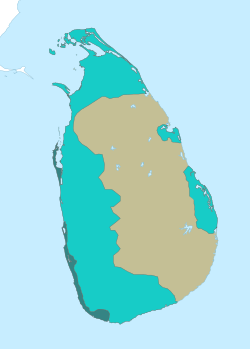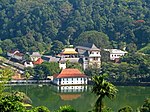Portuguese Ceylon
Jump to navigationJump to search
|
Portuguese Ceylon
|
|||||||||||
|---|---|---|---|---|---|---|---|---|---|---|---|
| 1597[1]–1658 | |||||||||||

Portuguese Ceylon (1597-1619)
Jaffna Kingdom and area annexed Kingdom of Sitawaka in 1594-1619
|
|||||||||||
| Status | Colony of Portugual | ||||||||||
| Capital | Colombo | ||||||||||
| Common languages | Portuguese Sinhalese Tamil |
||||||||||
| Religion | Roman Catholicism | ||||||||||
| King of Portugal | |||||||||||
|
• 1597–1598
|
Philip I | ||||||||||
|
• 1598–1621
|
Philip II | ||||||||||
|
• 1621–1640
|
Philip III | ||||||||||
|
• 1640–1656
|
John IV | ||||||||||
|
• 1656–1658
|
Afonso VI | ||||||||||
| Captain-Generals | |||||||||||
|
• 1597–1614
|
Jerónimo de Azevedo | ||||||||||
|
• 1656–1658
|
António de Amaral de Meneses | ||||||||||
| Historical era | Colonialism | ||||||||||
|
• Portuguese arrival
|
1505 | ||||||||||
|
• Death of Dharmapala of Kotte
|
27 May 1597[1] | ||||||||||
| 1633 | |||||||||||
|
• Surrender of Jaffna
|
June 1658 | ||||||||||
|
|||||||||||
Portuguese Ceylon (Portuguese: Ceilão Português, Sinhala: පෘතුගීසි ලංකාව Puruthugisi Lankawa, Tamil: போர்த்துக்கேய இலங்கை Porthukeya Ilankai) is the name given to the territory on Ceylon, modern-day Sri-Lanka, controlled by the Portuguese Empire between 1597 and 1658.
Portuguese presence in the island lasted from 1505 to 1658. Their arrival was largely accidental, and the Portuguese sought control of commerce, rather than territory. The Portuguese were later drawn into the internal politics of the island with the political upheaval of the Wijayaba Kollaya, and used these internal divisions to their advantage during the Sinhalese–Portuguese War, first in an attempt to control the production of valuable cinnamon and later of the entire island. Direct Portuguese rule did not begin until after the death of Dharmapala of Kotte, who died without an heir, and had bequeathed the Kingdom of Kotte to the Portuguese monarch in 1580.[2] That allowed the Portuguese sufficient claim to the Kingdom of Kotte upon Dharmapala’s death in 1597. Portuguese rule began with much resistance by the local population.[3]
Eventually, the Kingdom of Kandy sought help from the Dutch East India Company, with whom they initially entered into agreement. After the collapse of the Iberian economy in 1627, the Dutch–Portuguese War saw the Dutch conquest of most of Portugal’s Asian colonies – Ceylon included, between 1638 and 1658. Nevertheless, elements of Portuguese culture from this colonial period remain in Sri Lanka.
|
Part of a series on the
|
|---|
| History of Kandy |
 |
| Kingdom of Kandy (1469–1815) |
| Colonial Kandy (1815–1948) |
| Kandy (1948–present) |
| See also |
History[edit]
Arrival and establishment of the Portuguese (1505-1543)[edit]
|
This section needs expansion. You can help by adding to it. (October 2019)
|
The first contact between Sri Lanka and the Portuguese was established by Dom Lourenço de Almeida in 1505–6. It was largely accidental and it wasn’t until 12 years later that the Portuguese sought to establish a fortified trading settlement.[4]
The Kingdom of Kotte as a Portuguese vassal (1543-1597)[edit]
|
This section is empty. You can help by adding to it. (October 2019)
|
Annexation of Kotte and war with Kandy (1597)[edit]
|
This section needs expansion. You can help by adding to it. (October 2019)
|
Direct Portuguese rule began after the death of Dharmapala of Kotte who bequeathed the Kingdom of Kotte to the Portuguese monarch.[5] By 1600 the Portuguese had consolidated the main centers of rebellion, the Kelani and Kalu ganga basins, leaving the border regions to Sinhalese resistance.[6]
Conquest of Jaffna (1619)[edit]
|
This section is empty. You can help by adding to it. (October 2019)
|
Dutch conquest (1638-1658)[edit]
|
This section is empty. You can help by adding to it. (October 2019)
|
Administration[edit]
Administrative structure[edit]
|
This section needs expansion. You can help by adding to it. (October 2019)
|
Administrative divisions[edit]
|
This section is empty. You can help by adding to it. (October 2019)
|
Taxation[edit]
|
This section is empty. You can help by adding to it. (October 2019)
|
Military[edit]
|
This section is empty. You can help by adding to it. (October 2019)
|
Demographics and ethnicities[edit]
|
This section is empty. You can help by adding to it. (October 2019)
|
Economy[edit]
|
This section is empty. You can help by adding to it. (October 2019)
|
Legacy[edit]
|
This section is empty. You can help by adding to it. (October 2019)
|
Food
There are many foods of Portuguese influence that are still popular in Sri Lanka. For example, lingus and pastries.
Language
Sinhala words for certain types of Western attire/ furniture/ food & drink are derived from the Portuguese. Some examples are below:
| Sinhala Word | Meaning | Portuguese Word |
|---|---|---|
| Mesaya | Table | Mesa (Table) |
| Almaariya | Cupboard | Armário (Cupboard) |
| Sapaththuwa | Shoe | Sapato (Shoe) |
| Sidaadiya | City | Cidade (City) |
| Bébadda (colloq.) | Drunkard | Bêbado (drunkard) |

